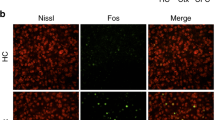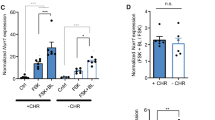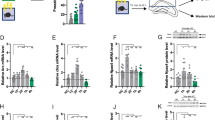Abstract
One of the molecular events associated with contextual long-term memory (LTM) formation is the induction of cyclic AMP response element (CRE)-mediated transcription1. Here we report that activation of NMDA receptors and of extracellular signal–regulated kinase (ERK) were necessary for stimulation of CRE-mediated transcription during contextual fear conditioning. In addition, we found that inhibition of CRE-regulated transcription during learning blocked LTM, which indicates that this transcriptional activity is critical for memory formation.
This is a preview of subscription content, access via your institution
Access options
Subscribe to this journal
Receive 12 print issues and online access
$209.00 per year
only $17.42 per issue
Buy this article
- Purchase on Springer Link
- Instant access to full article PDF
Prices may be subject to local taxes which are calculated during checkout



Similar content being viewed by others
References
Impey, S. et al. Nat. Neurosci. 1, 595–601 (1998).
Davis, H.P. & Squire, L.R. Psychol. Bull. 96, 518–559 (1984).
Tully, T., Preat, T., Boynton, S.C. & Del Vecchio, M. Cell 79, 35–47 (1994).
Yin, J.C. et al. Cell 79, 49–58 (1994).
Bourtchuladze, R. et al. Cell 79, 59–68 (1994).
Graves, L., Dalvi, A., Lucki, I., Blendy, J.A. & Abel, T. Hippocampus 12, 18–26 (2002).
Dash, P.K., Hochner, B. & Kandel, E.R. Nature 345, 718–722 (1990).
Guzowski, J.F. & McGaugh, J.L. Proc. Natl. Acad. Sci. USA 94, 2693–2698 (1997).
Pittenger, C. et al. Neuron 34, 447–462 (2002).
Gass, P. et al. Learn. Mem. 5, 274–288 (1998).
Morris, R.G., Anderson, E., Lynch, G.S. & Baudry, M. Nature 319, 774–776 (1986).
Atkins, C.M., Selcher, J.C., Petraitis, J.J., Trzaskos, J.M. & Sweatt, J.D. Nat. Neurosci. 1, 602–609 (1998).
Blum, S., Moore, A.N., Adams, F. & Dash, P.K. J. Neurosci. 19, 3535–3544 (1999).
Niehof, M., Manns, M.P. & Trautwein, C. Mol. Cell. Biol. 17, 3600–3613 (1997).
Taubenfeld, S.M. et al. J. Neurosci. 21, 84–91 (2001).
Acknowledgements
Microscopy and image analysis was performed in the W.M. Keck Center for Neural Signaling, University of Washington. This research was supported by National Institutes of Health grants NS 20498 and DC 04158. J.A. was supported in part by PHS NRSA T32 GM07270 from NIGMS and PHS NRSA 1F31MH064311-01 from NIMH. V.P. was supported in part by PHS NRSA 1F31NS042475-01 from NINDS.
Author information
Authors and Affiliations
Corresponding author
Ethics declarations
Competing interests
The authors declare no competing financial interests.
Supplementary information
Supplementary Fig. 1.
Representative confocal images showing CRE-regulated β-galactosidase immunostaining in hippocampal sections taken from transgenic CRE-lacZ reporter mice 8 h after contextual training. (a) The apparent increase in immunostaining within the CA1 region of the hippocampus (vehicle, conditioned) was attenuated by the pre-training infusion of the competitive NMDA receptor antagonist APV (APV, conditioned). Arrows indicate cannulation sites. (b) The apparent increase in immunostaining within the CA1 region of the hippocampus (vehicle, conditioned) is attenuated by the pre-training infusion of PD98059 (PD98059, conditioned). (JPG 55 kb)
Supplementary Fig. 2.
The diffusion and cellular uptake of CRE decoy ODNs are restricted to the CA1 region of the dorsal hippocampus. Confocal micrograph of the dorsal hippocampus of an animal infused 6 hrs prior with 5'-FITC-labeled CRE decoy ODNs. Green fluorescence corresponds to FITC and red fluorescence represents propidium iodide counter-stain. (JPG 25 kb)
Supplementary Fig. 3.
CRE decoy ODNs do not affect training session behavior. The mean velocities of mice infused with the CRE decoy ODNs 6 hr prior to training in contextual fear conditioning was unaffected during the training session, and they exhibited a response to the foot shock that was similar to that of the uninfused control (Conditioned) and scrambled ODN-infused control animals (Naive: n = 5, Conditioned n = 6, +CRE decoy n = 7, +Scrambled ODN n = 6; **** P < 0.01, *P < 0.05). (GIF 4 kb)
Rights and permissions
About this article
Cite this article
Athos, J., Impey, S., Pineda, V. et al. Hippocampal CRE-mediated gene expression is required for contextual memory formation. Nat Neurosci 5, 1119–1120 (2002). https://doi.org/10.1038/nn951
Received:
Accepted:
Published:
Issue Date:
DOI: https://doi.org/10.1038/nn951
This article is cited by
-
Ameliorative Effect of Cannabidiol on Topiramate-Induced Memory Loss: The Role of Hippocampal and Prefrontal Cortical NMDA Receptors and CREB/BDNF Signaling Pathways in Rats
Neurochemical Research (2023)
-
Hippocampal and prefrontal cortical NMDA receptors mediate the interactive effects of olanzapine and lithium in memory retention in rats: the involvement of CAMKII-CREB signaling pathways
Psychopharmacology (2020)
-
Intraventricular infusion of quinolinic acid impairs spatial learning and memory in young rats: a novel mechanism of lead-induced neurotoxicity
Journal of Neuroinflammation (2018)
-
Cross state-dependency of learning between tramadol and MK-801 in the mouse dorsal hippocampus: involvement of nitric oxide (NO) signaling pathway
Psychopharmacology (2018)
-
IL-4 mediated by HSV vector suppresses morphine withdrawal response and decreases TNFα, NR2B, and pC/EBPβ in the periaqueductal gray in rats
Gene Therapy (2017)



